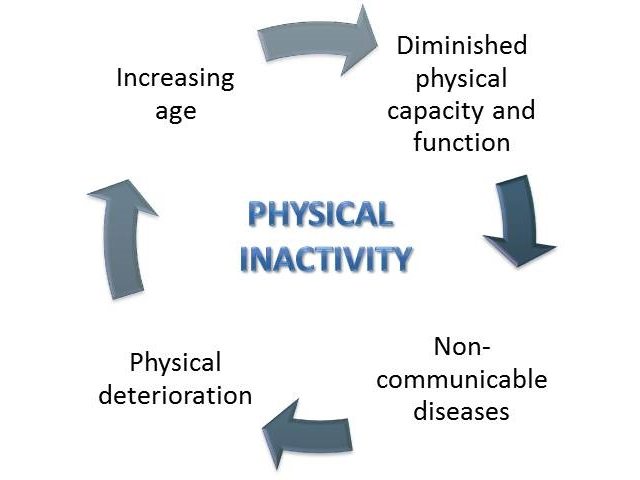Physical inactivity is the most prevalent factor associated with chronic non-communicable diseases
Physical activity and chronic non-communicable diseases
Physical inactivity is the most prevalent factor associated with chronic non-communicable diseases (NCDs), among other common risk factors such as obesity, unhealthy diets and excessive tobacco and alcohol use. NCDs such as coronary heart disease, type 2 diabetes, and breast and colon cancers, are one of the leading causes of death and ill-health worldwide. A decline in physical activity is commonly observed in people with chronic diseases and in certain populations, especially older persons, who often do not reach the recommended physical activity guidelines of a healthy lifestyle. This is a vicious circle where physical inactivity increases the likelihood of developing chronic diseases, and conversely, diminished physical capacity and functioning is frequently observed in patients with chronic diseases. In addition, physical activity is an important parameter to consider in evaluating the management of a chronic disease as well as the response to an intervention or treatment.
Assessing physical activity
Traditionally, self-report questionnaires or diaries have been used to describe the amount of physical activity achieved by patients during a period of time. This method is inexpensive and simple to use, however is subjective and may lack accuracy and reliability. Wearable technology is an emerging field that can be used as a potential tool to improve the precision and accuracy of objective physical activity measurement. Most commercially available accelerometers provide relatively accurate results for monitoring physical activity in the general healthy population, however measurements may be less precise when used in special populations, for instance individuals with slow or compromised gait. Therefore there is a need to design different algorithms for these devices in order to support their use in different populations such as patients with chronic diseases.
Research study
A research group at the University of Leeds, UK is currently using the *MOX accelerometer for their project to investigate gait patterns in various patients with NCD. The aim of this project is to develop tuneable algorithms to more accurately monitor physical activity in functionally comprised patient groups.
*The MOX accelerometer
The flexibility of the wireless MOX accelerometer greatly facilitates clinical research or interventions, and can be tailored to the specific needs of patient groups and caregivers. This required adaptability of the accelerometer algorithms and communication of the physical activity data with the other systems involved. In addition, there is research data to support the validity of the MOX accelerometer. The wireless physical activity sensor shows good correlation in daily living activities compared to the Actigraph GT3X, which is widely used in clinical research and known to correlate well with indirect calorimetry measures.
About the research group:
Dr Michael Backhouse
NIHR Clinical Trials Fellow, Leeds Institute of Clinical Trials Research
Senior Research Fellow, Leeds Institute of Rheumatic and Musculoskeletal Medicine
Valeria Filippou
PhD Student – CDT Tissue Engineering and Regenerative Medicine
Institute of Medical and Biological Engineering
University of Leeds

